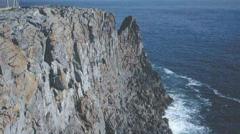What Happened to the Rock Climber Who Fell from a Cliff?

A Rock Climber's Accident in Pembrokeshire: A Comprehensive Overview
On a seemingly quiet Thursday evening, a rock climbing accident unfolded along the stunning Pembrokeshire coast, capturing the attention of local rescue teams and the wider climbing community. The incident involved a male climber who experienced a fall at Saddle Head, near the picturesque village of Bosherston. This event not only highlights the inherent risks associated with rock climbing but also underscores the importance of prompt rescue operations.
The fall occurred around 17:20 BST, prompting immediate action from emergency services. The Maritime and Coastguard Agency confirmed that the climber was airlifted to the top of the cliff for a swift transfer to an air ambulance, which subsequently transported him to a hospital in Cardiff. While the precise nature and extent of his injuries remain unclear, this incident serves as a reminder of the dangers climbers face, even in well-regarded climbing areas.
The Incident: Emergency Response
In response to the climber's fall, a coordinated emergency operation was initiated. The St Govans and Tenby Coastguard rescue teams quickly arrived on the scene, showcasing their expertise in cliff rescues. Additionally, RNLI all-weather lifeboats from Tenby and Angle were deployed to support the operation. A coastguard helicopter from Newquay in Cornwall was also scrambled, alongside two Wales air ambulances, highlighting the gravity of the situation and the need for rapid assistance.
Understanding the Climbing Environment
Pembrokeshire is renowned among the climbing community, particularly South Pembrokeshire, which is celebrated as one of the best sea cliff climbing areas in Britain. Saddle Head, where the incident took place, is known for its “fine climbing on good rock,” primarily catering to climbers of lower difficulty grades. The limestone cliffs, which ascend to approximately 35 meters (114 feet) above sea level, offer breathtaking views but also pose significant risks for climbers.
It’s important to note that the headland lies on the edge of the Ministry of Defence's Castlemartin range. This proximity means that access to the area can be restricted due to live firing exercises, adding another layer of complexity to the climbing experience.
The Risks of Rock Climbing
Rock climbing, while exhilarating and rewarding, comes with inherent risks. Understanding these risks is crucial for both seasoned climbers and novices alike. Here are key factors to consider:
- Equipment Failure: Climbing gear must be regularly inspected and maintained to ensure safety.
- Environmental Conditions: Weather changes can affect climbing conditions, making routes more dangerous.
- Physical Fitness: Climbers must be in good physical condition to handle the demands of the sport.
- Experience Level: It’s essential to choose climbs that match one's skill level.
- Partner Communication: Clear communication with climbing partners can prevent accidents.
Safety Measures for Climbers
To mitigate risks while enjoying this thrilling sport, climbers should adopt several safety measures:
- Training: Enroll in climbing courses to learn proper techniques and safety protocols.
- Use of Safety Gear: Always wear a helmet and use harnesses, ropes, and other protective gear.
- Pre-Climb Checks: Inspect all equipment before starting a climb.
- Stay Informed: Keep updated on weather conditions and any access restrictions in climbing areas.
- Emergency Plans: Have a plan in place for emergencies, including knowing the fastest route to summon help.
The Role of Rescue Services
The swift response from rescue services in this incident cannot be overstated. Teams like the St Govans and Tenby Coastguard are highly trained to handle cliff rescues, which often require specialized skills and equipment. The presence of multiple rescue units, including RNLI lifeboats and air ambulances, exemplifies the critical nature of their work in ensuring climbers' safety.
In cliff rescue scenarios, time is of the essence. The ability to quickly assess the situation, locate the injured climber, and provide necessary medical assistance can significantly impact outcomes. This incident underscores the importance of having well-coordinated rescue operations ready to respond to climbing accidents.
Community Impact and Awareness
Accidents like the one at Saddle Head serve as a stark reminder to the climbing community about the importance of safety and preparedness. They also highlight the need for ongoing education about the risks associated with climbing and the best practices to minimize those risks. Climbing organizations, local authorities, and experienced climbers can play significant roles in fostering a culture of safety.
Moreover, sharing experiences and knowledge among climbers can help to raise awareness about safe climbing practices. Engaging in discussions about recent incidents can also serve as valuable learning opportunities, promoting a safer climbing environment for everyone.
Conclusion
The rock climber's fall at Saddle Head is a poignant reminder of the risks involved in this thrilling sport. While the climber’s condition remains undisclosed, the collaborative effort of rescue teams showcases the commitment to ensuring climber safety along the Pembrokeshire coast. As the climbing community reflects on this incident, it is essential to continue promoting safety, preparedness, and awareness to prevent future accidents.
As climbers, we must ask ourselves: How can we enhance our safety measures to ensure that we enjoy our passion without unnecessary risk? The importance of being aware of our environment and adhering to safety protocols cannot be overstated.
FAQs
What should I do if I witness a climbing accident?
If you witness a climbing accident, call emergency services immediately. Provide them with as much detail as possible about the location and nature of the incident. Stay with the victim if it is safe to do so, and keep them calm until help arrives.
How can I prepare for a climbing trip?
To prepare for a climbing trip, ensure you have the right gear, check weather conditions, and inform someone about your plans. It's also wise to review climbing techniques and safety protocols before heading out.
What are the best practices for climbing safety?
Best practices for climbing safety include using proper gear, conducting pre-climb checks, communicating clearly with your climbing partner, and staying within your skill level. Always be aware of your surroundings and potential hazards.
As we reflect on this incident, we must continue to prioritize safety in our climbing endeavors. Let’s strive to ensure that our experiences are not only thrilling but also secure. #ClimbingSafety #Pembrokeshire #RockClimbing
Published: 2025-08-07 21:10:18 | Category: wales



